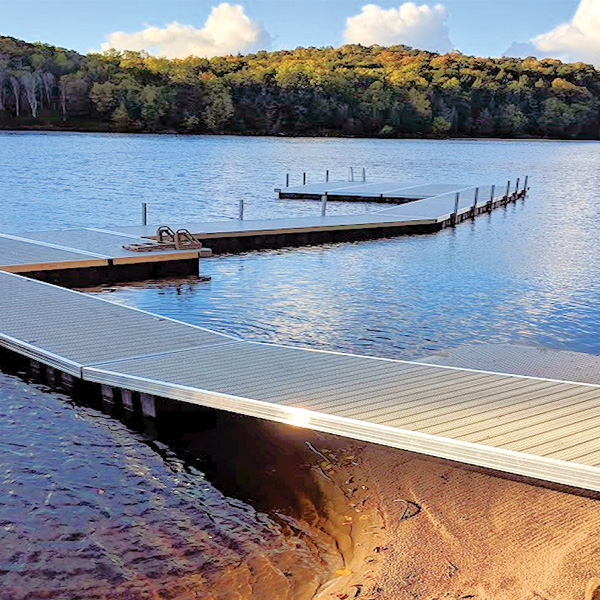Crafting Customized Solutions: Why a Floating Dock Builder is Necessary for Distinct Requirements
Crafting Customized Solutions: Why a Floating Dock Builder is Necessary for Distinct Requirements
Blog Article
Upgrade Your Beachfront With Sturdy Floating Docks
Updating your waterfront with durable floating docks can dramatically enhance both capability and aesthetics, supplying a functional solution for various water activities. With an array of products readily available, including low-maintenance choices and typical wood, picking the appropriate dock can match your personal style and meet sensible needs.
Benefits of Floating Docks
Floating docks deal a multitude of benefits that enhance their charm for different maritime applications. Unlike standard set docks, floating docks surge and fall with the trend, guaranteeing regular access for boats and watercraft no matter of ecological conditions.
In addition, floating docks are simpler to set up and transfer, providing versatility for temporary or seasonal use. Their modular layout permits for modification to fit certain needs, whether for exclusive marinas, domestic waterfronts, or industrial applications.
Additionally, floating docks create minimal disruption to the marine setting, preserving neighborhood ecosystems and minimizing the likelihood of erosion. They likewise provide improved safety and security and security for customers, as their resilient nature uses a much more flexible surface area than stiff frameworks.
Furthermore, floating docks can facilitate a diverse variety of tasks, such as angling, swimming, and entertainment boating, making them a valuable possession for beachfront advancement. Their flexibility and practicality make floating docks a favored option for a selection of maritime projects.
Picking the Right Products
Picking suitable materials for floating docks is crucial to their longevity, performance, and general performance. When picking materials, consider factors such as environmental direct exposure, maintenance requirements, and architectural stability. Usual materials include timber, plastic, aluminum, and composite alternatives, each offering unique advantages and drawbacks.
Wood, while cosmetically pleasing, requires normal upkeep to protect against rot and degeneration. Pressure-treated timber can enhance resilience, but it might still catch water damages with time. Plastic floats, often made from high-density polyethylene, are resistant to deterioration and need minimal maintenance, making them an attractive option for low-maintenance applications.
Aluminum is an additional practical choice, recognized for its strength and lightweight properties. It is immune to rust and can hold up against harsh weather problems, although it might be more pricey than other materials. Composite products integrate the most effective characteristics of wood and plastic, supplying a durable and low-maintenance option that resembles the look of wood without the associated disadvantages.
Ultimately, the option of product should align with the intended usage, environmental factors to consider, and budget restrictions, guaranteeing a functional and resilient floating dock that satisfies your specific requirements.
Setup Process Overview
The effective setup of a drifting dock relies upon mindful planning and implementation, guaranteeing that it operates successfully in its designated setting. The initial step involves analyzing site problems, including water deepness, coastline features, and dominating weather patterns, which will certainly educate the dock layout and check my source anchoring system.
Following the website evaluation, the next stage is to prepare the floating dock elements. This consists of putting together the frame, protecting floats, and his response attaching any kind of essential hardware. It is essential to ensure that all connections are waterproof and robust to hold up against marine conditions.
Once the dock is put together, the setup procedure begins with positioning the dock in the water. This can include a crane or various other lifting equipment, especially for bigger frameworks. Appropriate alignment is important for performance and safety.

Maintenance Tips for Longevity
Routine maintenance is crucial for making sure the longevity and ideal performance of a floating dock. To attain this, begin with routine inspections a minimum of two times a year, concentrating on the stability of the dock's structure, including the flotation gadgets and connecting equipment. Try to find indications of deterioration, damages, or wear, and address any problems promptly to stop additional degeneration.
Cleaning up is another crucial facet of maintenance. Eliminate debris, algae, and barnacles from the dock's surface area to avoid unsafe problems and preserve visual charm. Utilize a soft brush and a mild detergent to stay clear of harming the dock's materials.
In addition, guarantee that the dock is correctly anchored and safeguarded to endure seasonal changes in water degrees and moved here weather condition problems. Check the anchoring system for security and make adjustments as needed.
Enhancing Your Exterior Aesthetic
To develop a visually attractive exterior space, including a floating dock can significantly improve the general visual of your waterfront residential or commercial property. Floating docks are not just functional yet can additionally offer as a striking centerpiece that matches the natural environments - floating dock builder. Offered in various materials and styles, these docks can be customized to match your building's architectural style and landscape
The addition of decorative components, such as integrated illumination or trendy railings, better elevates the dock's visual charm. Consider using all-natural wood finishes, which mix seamlessly with the atmosphere, or selecting modern-day products like aluminum or composite decking that use a streamlined, contemporary appearance.
Purposefully placing planters or seating areas on or around the dock can develop welcoming spaces that encourage relaxation and satisfaction of waterside views. In addition, incorporating shades and textures that balance with your landscape will produce a cohesive aesthetic throughout your exterior area.

Verdict

Upgrading your beachfront with sturdy floating docks can significantly improve both performance and looks, supplying a versatile service for various water activities. Unlike conventional fixed docks, floating docks rise and loss with the trend, ensuring constant accessibility for boats and boat no matter of ecological problems.Selecting appropriate materials for floating docks is essential to their longevity, performance, and total effectiveness.As soon as the dock is assembled, the installment process starts with positioning the dock in the water.In recap, floating docks deal various benefits, consisting of versatility to water degree changes and a range of material options.
Report this page